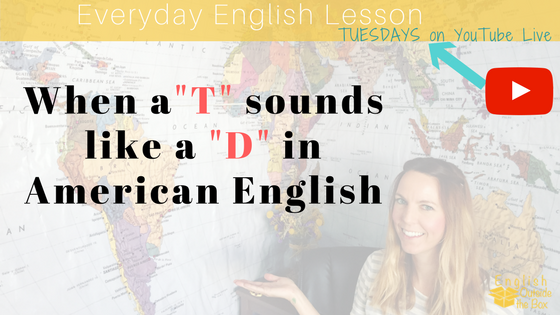
Everyday English LIVE Lesson: When a T sounds like a D
“Progress is impossible without change….” George Bernard Shaw
Change is necessary for a lot of things, like progress and moving forward. It’s important for growth, and it’s always important if you’re wanting to see a different result.
You may have noticed a change here on English Outside the Box. I have made some changes, and hope they help you continue to progress in your English skills, and help you move forward.
For the past several weeks, this Tuesday English lesson was available in the early hours of the day and with a video replay from the previous Saturday. This has changed. Now, you can join me live on YouTube every Tuesday at 8:30 am PST (Los Angeles) for your “Everyday English” lesson. This live lesson will help you with your English fluency for daily use, as we’ll review things like pronunciation, grammar, vocabulary, and more!
After the live English lesson, the video will be posted right here with the lesson notes, and written (visual) information about what we learned.
If you were not able to join me live, that’s OK! The replay is available and still a great addition to your weekly study resources. Review the lesson notes, watch the video, and participate with my questions by commenting below or writing them down on your own piece of paper.
In today’s lesson you are going to learn:
- When a “T” sounds like a “D” in English
- How to link words together
- The difference between a verb + particle and verb + preposition
Everyday English Lesson Notes
We started this lesson with a challenge. Now, you can complete it too.
How many phrasal verbs are in this sentence?
I looked up and saw the man I looked up to looking up a word in the dictionary.
If you answered 2, then you are absolutely correct!
If you answered 3, then you are making a common mistake of confusing a preposition and a particle.
Let’s review
looked up = verb + preposition
looked up to = verb + particle — this is a PHRASAL VERB
looking up = verb + particle — this is a PHRASAL VERB
So, what’s the difference between a preposition and a particle? They look the same; however, they do something very different. A preposition does not change the meaning of the verb, it just adds information and detail to it. In this first example, the word “up” is telling us where to look. The meaning of look stays the same, and it keeps its definition.
However, in the other 2 sentences, “up” changes the meaning of the verb. In the first example, it’s not giving us additional details, rather it’s expressing the idea that we admire someone. To look up to someone means to admire them. In the second example, the particle changes the meaning of look to mean to search for information (like a definition in a dictionary).
So a verb + preposition is not a phrasal verb because the preposition is not changing the meaning of the main verb, it’s just giving it detail.
The lesson gave another sentence challenge. How many phrasal verbs are in this sentence?
I get on with everyone when I get on the bus.
If you said 1 phrasal verb, then you are absolutely correct!
If you said 2 phrasal verbs, then you are still confusing a preposition and a particle.
get on with everyone = to have a good relationship with everyone, to get along with
get on (the bus) = to step inside the bus
As you can see above, the second “get on” use a preposition “on” (not a particle), giving more details about “where” we are “getting”.
Pronunciation:
When does a “T” sound like a “D”?
In American English, a “T” sounds like a “D” when it comes in between 2 vowel sounds.
So both of my phrasal verbs today showed you how the “T” sounds like a “D” and allowed you to hear (and practice) linking.
Listen back to the video and hear how the connection of “get on” and “looked up” sounds. You should hear:
get on = “gehdon”
looked up = “lookdup”
The first connection is obvious because you can see a “T” in “get on”, but where is the “T” that I am talking about in “looked up”? It’s important to know that words that end in -ED have 3 sounds, an -ID, -D, and a -T. The past tense of look, looked, has an ending “T” sound. However, as you can hear in the video, the “T” sound changes to a “D” because it’s in between 2 vowel sounds.
Practice Makes Perfect
To practice what you’ve learned today, I want you to make sentences utilizing the new phrasal verbs. You can write them in the comments below or in your own notebook.
To practice pronunciation, replay the video above and repeat what you hear me say. You can listen, pause, repeat…rewind and continue until you feel comfortable with the sound.
Alright, I hope this lesson helped you feel 1 step closer to comfortable and confident English for your daily use. Come back here, to this website on Saturday (and every Saturday) for another new English surprise!
Did you like this lesson? Please share it with a friend! Help me…help them. It’s easy with the share buttons below.
Until next time,
Happy Studying! ♥
Remember my conversation club is now open for enrollment!
Improve your speaking and conversation skills by speaking every week! Connect with me, another native speaker, and conversation partners to practice using more phrasal verbs and natural English.

